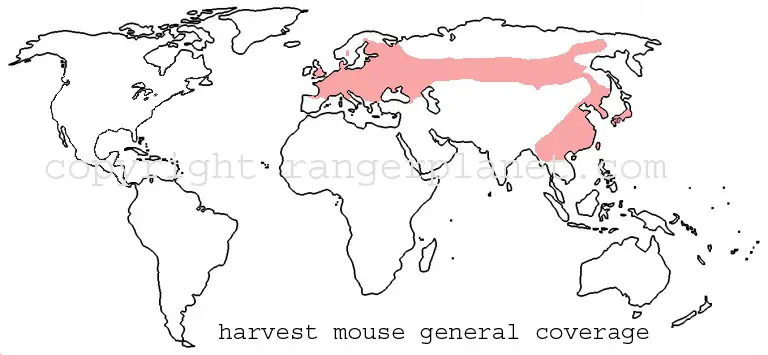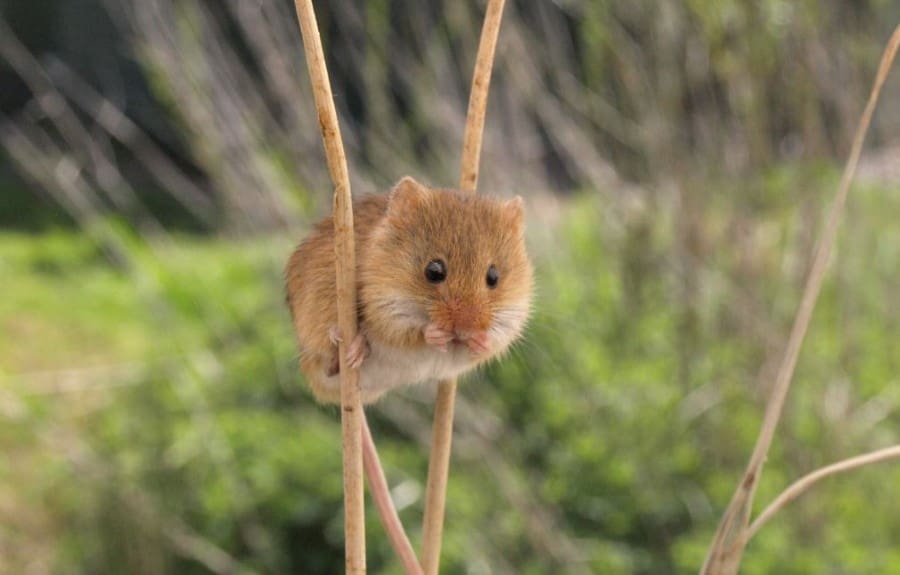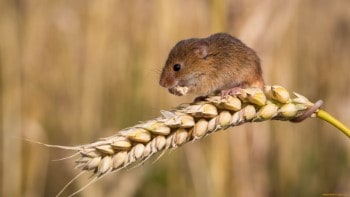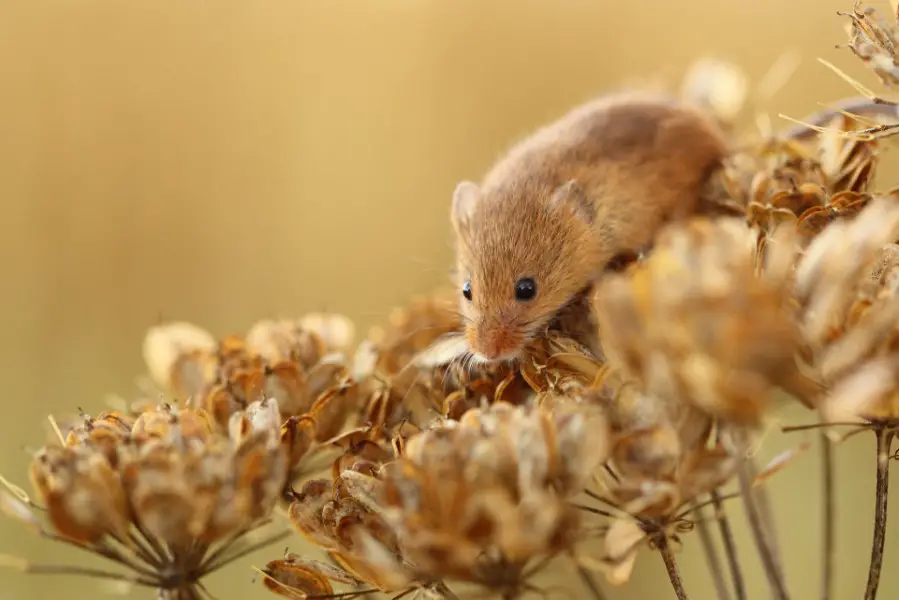Here we’re going to discuss Harvest Mice appearance, diet, habitat, classification, breeding, nesting, conservation, and more about the harvest mouse!
These cute creatures are often lost among the other great mice that people learn about and have as pets, but the humble little harvest mouse just keeps on doing what it does – almost without being noticed. Maybe that’s because of its small size?
So we thought we’d give their profile a bit of a lift, and here it is. But first, let’s just make sure we all know what a Harvest Mouse is?
The harvest mouse’s scientific name is Micromys minutus, and is a mammal native to Europe and Asia. It’s a nocturnal omnivore (feeding on both plants and invertebrate animals) that lives in grassland, farmlands, and related habitats. The harvest mouse is the only mammal in the UK that builds a nest above ground.
And yes, many find this animal to be just as cute as they are interesting. Below is a complete guide on this tiny animal …that many often confuse with other types of mice…

Classification
Kingdom: Animalia
Phylum: Chordata
Class: Mammalia
Order: Rodentia
Family: Muridae
Genus: Micromys
Species: M. minutus (Harvest Mouse)
Harvest mouse history
Here’s we’re going to provide a brief summary of the Harvest Mouse origin and distribution.
The harvest mouse being native to Europe and Asia means it’s also often called a “Eurasian mouse”
It’s found from the North Yorkshire region of England, right across most of Europe, and slices through Asia to the orient.
The harvest mouse belongs to the subfamily Murinae (Murinae is from the mouse family Muridae). While currently there are only one species of harvest mouse, some speculate additional species could exist. The closest living relatives to the harvest mouse are known to be the Wood mouse.
Where Harvest mice live
The Harvest mouse spread is an interesting one, they have mainly colonized a band of habitats across Europe and Asia. This area provides the correct temperate climate, and the right crop source to be suitable for their habitation needs. Let’s take a look in detail.
Geographical presence/expansion
The geographical distribution of harvest mouse mainly covers the continent it’s native to which is Europe and Asia.
The harvest mice population has also expanded to subcontinents such as East Asia, Western Asia, and Southeast Asia. More specifically countries like Armenia, Asam, China, Czech Republic, Bosnia, Herzegovina, Bulgaria, Austria, Azerbaijan, Belarus, Belgium, Japan, Croatia, Siberia, and Korea have a good spread of the harvest mouse population.
Harvest mouse geographical map

Conservation status
The harvest mouse is becoming more scarce. The loss of population is thought to be caused by changes in habitat management and agricultural methods. But there are no reliable studies to exactly specify the cause for the decline in the harvest mouse population.
They are not endangered. So with the hope of conserving and reducing the decline in their population, they’re now listed as a BAP (Biodiversity Action Plan) Species.
They’re also protected in the UK – covered under the Wildlife and Countryside Act, 1981, and listed as priority species under the UK Post-2010 Biodiversity Framework.
Harvest mouse appearance
The harvest mouse is the smallest rodent in Europe. It has a blunt nose, small eyes with small hairy ears. It also has stubble-like whiskers and thick, soft fur which are somewhat thicker in winter than in summer.
Its broad feet are specially designed for it climbing with a somewhat opposable, large outermost toe. This design of the feet helps the mouse to grip stems with each hind foot and its tail, which will easily free the mouse’s forepaws for food collection.
The specialty of the harvest mouse’s appearance is its tail. It has a prehensile tail that is furless at the tip and nearly the same size as its body. The tail helps the mouse in balancing too.
Harvest mouse Color
The harvest mouse has pale, glossy, russet orange ginger or yellow fur. The upper body is brown with a little yellow or red tinge. Whereas the underside of the body takes the colors between white to cream. And its tail is bicolored.
Harvest mouse Size
The size of a house mouse ranges somewhere between 55 to 75 mm (2.2 to 3.0 in) long or in some cases between 50-70 mm. Whereas its tail measures between 50 to 75 mm (2.0 to 3.0 in) long. Somehow the size of the body of a harvest mouse and its tail will almost be the same.
Harvest mouse weight
The harvest mouse weighs from 4 to 11 g (0.14 to 0.39 oz) or in some cases between 4 to 6g. As a comparison on weight, it weighs half the weight of your typical house mouse (Mus musculus)



Harvest mouse lifespan
The life span of this tiny little animal is about 1.5 years to 18 months on average. The main causes of mortality are:-
- Cold and wet weather
- Sudden frosts
- Predation.
Harvest mouse diet
The harvest mouse is an omnivore, meaning they eat both plants and animals …or to be more specific – invertebrate animals. They eat a mixture of the following…
- Small Insects
- Seeds
- Berries
- Grass
- Fruit
- Grain
The grain is from cereal heads (leaving the sickle-shaped remains). It’s mostly in summer they feed on insects, larvae, moss, and even fungi.
Harvest mouse habitat
Although harvest mouse is a climber, it’s a ground-based animal. It lives in many places on the ground such as the following:-
- Grassland
- Farmland
- Wetland
- Reed beds
- Hedgerows
- Woodland edges
- Dykes
- Salt marshes
- Roadside verges
Most areas of tall grass provide the harvest mouse with a favorable habitat with sufficient sources of food.
Harvest mouse nesting habits
One of the most obvious signs of a harvest mouse is a breeding nest. As we said the harvest mouse is the only British mammal to build nests just above the ground. A Harvest Mouse builds its nests in dense vegetation such as grasses, rushes, wheat, grassy hedgerows, ditches, and brambles.
These nests are built 30cm above the ground in short grasses and up to a meter in tall reeds. The diameter of the nests may differ based on whether the harvest mouse is breeding or not. For Breeding Nests, the diameter Is around 10 Cm, whereas for non-breeding the diameter is about 5cm.
Nocturnal animals
Like most of the mice species, harvest mice are nocturnal. But they may also be active during the day in warm summer months making them arguably cathemeral.

Harvest mouse mating and breeding
Little is known about the mating habits of harvest mice. But as a fact, a male and female harvest mouse is known to come together only to mate and to construct a breeding nest.
Then after mating has finished, the female chases away the male and begins preparations for her brood. A male harvest mouse is known as “Buk”, a female “Doe” and a baby “pup”, “pinkie” and/or “kit”.
The breeding season is between august – September usually but may extend to December if the weather is mild. This is because as mentioned, cold or wet weather is the main reason for mortality in harvest mice. The pregnancy duration of harvest mice (gestation period) is about 17- 18 days and the female harvest mouse carries anything from 3-8 pups (babies).
A harvest mouse can have two or three litters in a year and a fresh nest is built for each litter. Construction of nests for breeding starts during the spring and summer breeding season. These nests are usually built 100-130 cm above the ground. Usually, for breeding a spherical nest made of tightly-woven grass is built high up in the tall grasses.
The pups are born naked, blind, and hairless. They open their eyes around 8 – 10 days after birth and they grow so quickly.
By the 11th day, they’re ready to step out and at 15-16 days a pup should have reached maturity enough to be independent. So from that point, the pups are abandoned by the mother. In fact, harvest mice become reproductively mature in just 35 days after birth.
Harvest mouse hibernation and winter
Harvest mouse does not hibernate. During the cooler months and mostly in winter harvest mice build a winter/sleeping nest, made out of grasses, on the ground or if they can’t find a better shelter than in a shallow burrow.
Instead of hibernating they sleep in their nests for long periods and wake up at intervals to have a little stored food or go out on foraging trips. In severe winter harvest mice sometimes find shelter in barns and outbuildings. But even if it shelters, it’s during the winter that many harvest mice die.
Harvest mouse colonies

The harvest mouse is social and lives in small local colonies peacefully with other mice species with overlapping home territories.
But sometimes the harvest mice can have an outbreak of violence. For a fact, the outbreak of violence in harvest mice can lead to a mouse missing a part of its tail or having bites on the rear.
What eats harvest mice?
Harvest mouse makes a tasty meal for many animals (natural predators). Animals like
- Cats
- Stoats
- Owls
- Crows
- Kestrels
- Weasels
- Toads
- Pheasants
Yes, even pheasants eat them. Plus some other types of predatorial birds and animals. Here’s a complete list of what eats mice. And out of interest, you can also find a complete list of what eats rats.
Are Harvest mice pests?
Rodents are indeed pests that destroy crops, but the harvest mouse is not the same. Harvest mouse doesn’t eat enough to cause damage to crops and for this reason, the farmers don’t mind having them. They also can help farmers destroy pests by eating pest insects.
Can you have a Harvest mouse as a pet?
As much as it may sound unusual, yes! Harvest mice make great pets. They are easy to keep in a healthy condition (which is one of the main concerns in having a mouse as a pet) but they may not be your touchy-feely pets like cats and dogs.
At first, the harvest mouse does need to learn to be around people and their active surroundings and then should start to behave as normally as you would expect. But as pets, harvest mice will have special food, water, and even shelter requirements which you should ideally learn before having one as a pet.
Is a Harvest mouse the same as a Dormouse?
Harvest Mice and Dormice are not the same. At first glance, they might seem it, but the dormouse is larger than a harvest mouse. The harvest mouse has smaller eyes compared to the big black eyes of a dormouse. The same goes with ears, where the dormouse has medium-sized ears – the harvest mouse has smaller ears. The dormouse also has a furry tail when compared to the less fairy harvest mouse tail.
When it comes to the colors in the body of these two mice, the dormouse has an orange/yellow or darker coat on top with a yellow underside and white on the throat. Whereas the harvest mouse has a golden-brown color on top with a very pale grey/white underside.
Check out our article on everything you need to know about the Dormouse.
Here’s a cute video showing harvest mice, in their natural habitat, feeding and exploring.
Resources
Pet Mouse Happy Care Guide
Because you’re going to want to know how to care for your harvest mouse!
If You Take a Mouse to School
A wonderful children’s book. The famous mouse from ‘If You Take a Mouse to the Movies’ and, ‘If You Give a Mouse a Cookie’ – is back for his first day of school.
Conclusion
We hope this has been useful in understanding more about the harvest mouse, be sure to check out the resources above.
